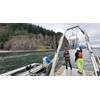Kraken Enters R&D Partnership with NOAA
Kraken Robotics Inc. announced that its wholly owned subsidiary Kraken Robotic Systems Inc. has signed a Cooperative Research and Development Agreement (CRADA) with the Office of Ocean Exploration and Research (OER) of the National Oceanic and Atmospheric Administration (NOAA).
The data and information OER collect can be used to enhance ocean research, inform policy and management decisions, develop new lines of scientific inquiry, and advise NOAA and the United States on critical issues.
The agreement signed between Kraken and NOAA’s OER defines a joint research and development partnership exploring the application of Kraken’s underwater sensor and robotic technologies and systems to NOAA’s ocean observation charter in potentially more effective (less expensive, better results, more environmentally friendly) ways. The collaboration is directly responsive to NOAA’s OER mission of reducing unknowns in deep-ocean areas and providing high-value environmental intelligence.
This CRADA has three primary objectives:
- Testing of Kraken’s AquaPix Synthetic Aperture Sonar (SAS) system aboard an autonomous underwater vehicle (AUV) and/or towed system (KATFISH) on a NOAA vessel. This test would involve the integration and in-situ test of this technology aboard a NOAA vessel. This test will provide both parties with experience at sea while collecting data for further analysis, with NOAA providing sea time and Kraken will provide mapping sensor equipment. Mapping data will be shared by both Kraken and NOAA for analysis.
- Testing of Kraken’s SeaVision laser scanner integrated aboard NOAA ROV systems and/or a Kraken ROV. Testing this technology in the field will give both Kraken and NOAA the opportunity to evaluate this new technology in the field at depths as great as 6,000m and advance underwater scanning technologies. NOAA will provide sea time and Kraken will provide mapping sensor and equipment. 3D scanning data will be shared by both Kraken and NOAA for analysis.
- Testing of other Kraken mapping systems, sensors, batteries and robotic systems at sea, and transferring of data in real time from NOAA vessels to land based monitoring and command stations which will further benefit ocean exploration and the development of technologies.
“We are excited to enter into our first CRADA with NOAA,” said Karl Kenny, Kraken’s President and CEO. “The Office of Ocean Exploration and Research is a fast moving and forward-thinking division of NOAA, always eager to identify and adopt the latest marine technology available to increase the efficiency and capability of their missions. We are highly impressed with the telepresence capability aboard the NOAA ship Okeanos Explorer and OER's goal to provide real-time data from their expeditions to the scientific community. We feel this will be a truly symbiotic relationship between NOAA OER and Kraken by combining their real-time, global data transfer capabilities with our real-time processing incorporated to all of our sensors, allowing for high-resolution laser and sonar data to travel from the seafloor to researchers around the world at an unprecedented rate.”












 December 2025
December 2025



